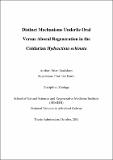| dc.contributor.advisor | Frank, Prof. Uri | |
| dc.contributor.author | Bradshaw, Brian | |
| dc.date.accessioned | 2015-03-18T13:43:21Z | |
| dc.date.available | 2015-03-18T13:43:21Z | |
| dc.date.issued | 2014-10-24 | |
| dc.identifier.uri | http://hdl.handle.net/10379/4911 | |
| dc.description.abstract | Distinct mechanisms underlie oral versus aboral regeneration in Hydractinia echinata. Head regeneration is preceded by stem cell migration, proliferation and blastema formation. After decapitation stem cells migrate from the aboral band, proliferate and form a blastema. Cell proliferation is essential for head regeneration as regeneration cannot be completed when proliferation is blocked. The i-cell genes Piwi1, Pl10, Myc2 and Vasa plus the nematoblast differentiation marker Ncol1 are expressed in or below the blastema during regeneration. RNAi knockdown of these genes revealed that they are not required for blastema development but are required for regeneration.
The generation of a transgenic stem cell reporter animal enabled the tracking, for the first time, of single transgenic cells in vivo during Hydractinia regeneration. This was a major breakthrough and revealed the migration and proliferation of Piwi1+GFP stem cells from the i-cell band to the blastema and the contribution these cells play in regeneration.
Aboral regeneration occurs in a completely different way and time scale. It does not involve blastema formation but rather a transformation of tissue identity from polyp to stolon. It is preceded by the loss of Wnt3 expression and the anterior-posterior polarity of the polyp. This is then followed by the reabsorption of tentacles and head structures and a change in the restricted distribution of stem cells. Once transformed this new stolon tissue can found a new colony and continue to sexually reproduce being able to contribute to further generations.
These results reveal that Hydractinia polyps regenerate by epimorphosis and are capable of regenerating lost tissues in two distinct ways. Cell proliferation and blastema formation are essential in distal regeneration in Hydractinia indicating a possible evolutionarily conserved mechanism within the Metazoa. | en_US |
| dc.rights | Attribution-NonCommercial-NoDerivs 3.0 Ireland | |
| dc.rights.uri | https://creativecommons.org/licenses/by-nc-nd/3.0/ie/ | |
| dc.subject | Hydractinia | en_US |
| dc.subject | Regeneration | en_US |
| dc.subject | Stem Cells | en_US |
| dc.subject | Migration | en_US |
| dc.subject | Blastema | en_US |
| dc.subject | Department of Zoology | en_US |
| dc.subject | School of Natural Sciences and Regenerative Medicine Institute (REMEDI) | en_US |
| dc.title | Distinct mechanisms underlie oral versus aboral regeneration in the cnidarian hydractinia echinata | en_US |
| dc.type | Thesis | en_US |
| dc.contributor.funder | SFI, PRTLI | en_US |
| dc.local.final | Yes | en_US |
| nui.item.downloads | 606 | |


